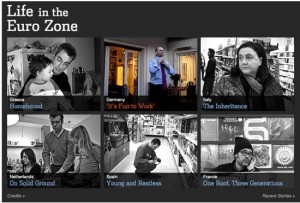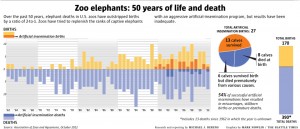“The Eurozone Meltdown”
by The Wall Street Journal was a series, which I thought captured the true essence of data storytelling. Sarah Slobin explained how tell an issue as big and complex as the European meltdown through the stories of people from the countries who were experiencing this first hand. What I really thought was interesting was how Slobin related the European meltdown with the American meltdown in 2008. Slobin who was laid off and remembered how hard it was talking about money and jobs at the dinner table each night in front of her daughter. My making this large business/ economic story personal, The Wall Street Journal was able to describe the affects the meltdown had on the people of Europe. By telling human stories, the WSJ didn’t overlook data or weaken their reporting. They used the data they had to find the best stories to tell. This to me is the whole point of writing data stories –
“In the end, the data were the people, they were the photographs and the stories. They were what was framing each narrative and driving the tension between the countries,” Slobin said.
This part resonated with me, because the whole point of accumulating data and trying to understand it is to tell the important stories.
“Segregation Now”
Is on of my favorite data visualization stories. The series is about in 1954, Chief Justice Earl Warren, in his landmark Brown v. Board of Education opinion that sought to outlaw segregation in America’s schools, wrote, “Education is perhaps the most important function of state and local governments.” “In these days, it is doubtful that any child may reasonably be expected to succeed in life if he is denied the opportunity of an education. Such an opportunity, where the state has undertaken to provide it, is a right which must be made available to all on equal terms,” Warren wrote. Today, the equal educational terms the Supreme Court hoped for – indeed, demanded – are imperiled again.
Almost everywhere in the country the gains of integration have been eroded. And nowhere has that been more powerfully and disturbingly true than in the South. “Segregation Now” focuses on the Tuscaloosa, Ala., city school district, and its fleeting experience with the challenges and virtues of integration. The story is told through the three generations of one African-American Tuscaloosa family, the Dents.
Segregation Now: 60 Years After Brown v. Board from ProPublica on Vimeo.
The presentation includes: a 9,000-word article; a beautiful and arresting collection of photographs taken by students in Tuscaloosa high schools; an interactive timeline tracing the arc of segregation, integration and resegregation. This is an unbelievable series, which truly grasps how the American education system is failing its minority students. My other favorite series is The Seattle Times examination on elephant deaths in U.S. zoos called,
“GLAMOUR BEASTS: The dark side of elephant captivity.”
The industry doesn’t comprehensively track elephant births and deaths. They obtained records of zoo elephants for more than a century. They focused our analysis on the past 50 years, beginning in 1962 with the birth of Packy at a Portland zoo — the first elephant to be born in a zoo in North America. This series is really interesting, because it also has tracks the history of specific linage of elephants.


